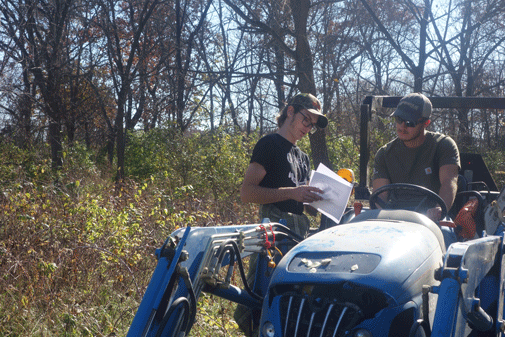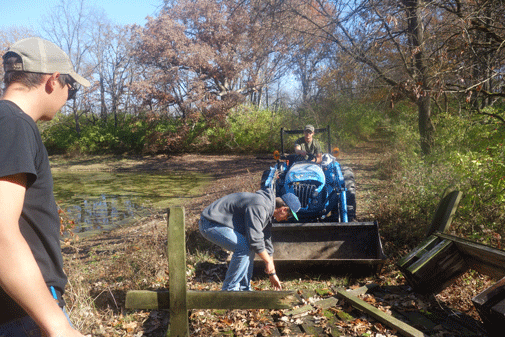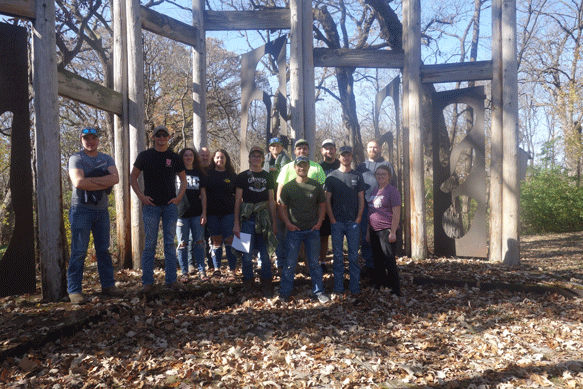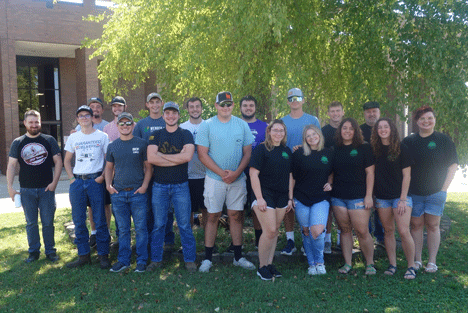Alpha Gamma Tau members, comprised of students in the agriculture program, and members of SEA (Students for Environmental Action) at Spoon River College met in early fall to discuss how the two groups could work together on projects that would benefit the land, students and the community. They chose the Spoon River College Arboretum, a 10-acre tract of native trees and trails on the northern edge of the SRC Canton Campus.
“My vision for the SRC Arboretum is to bring it back to its original glory. The arboretum construction and past use is a piece of our college’s history that I think many faculty, students, and those within our community forget about,” said Allyson Smith, agriculture faculty and advisor for AGT.
The idea of an arboretum was born and sponsored by the SRC Foundation in 1979 for use as an outdoor learning laboratory, as well as for community groups such as art, photography, bird watching, and wildlife study. Development began in 1980, funded by private donations, fund-raising efforts, and a $55,853 grant from the Illinois Department of Commerce and Community Affairs.
One significant contribution was the Ezra J. Clark Memorial Woodland Theatre, given by Clark’s widow as a memorial to her late husband. Constructed with rustic telephone poles, railroad ties, and panels of Coretan steel which would rust to a specified depth, then SRC board trustee Dr. Lowell B. Fisher said “We wanted it to look not as if it were placed there, but as if it grew there.”
It was used at one time for performances of the Spoon River Anthology and even weddings but over the years, time, nature, and lack of upkeep have taken its toll. While the theatre structure itself is in good shape, rest areas and bridges have rotted and collapsed, and trails and the native tree groves have become overgrown.
“I would love to see the theater rehabbed, an interactive tree ID scavenger hunt, rest stops rebuilt, and the trails remapped,” Smith said. “My students and I have already started working on creating a new map of the trails to be posted at the entrance along with other historical information about the arboretum. We have also began removing rotted and un-safe look outs and benches.”
The rotted wood and debris from trees that is being removed will be part of a bonfire that the two student groups decided on for a student event.
“The arboretum provides forestry and conservation educational opportunities to not only the agriculture department, but also many other departments throughout the college,” said Smith. “Biology faculty Amy Rutledge takes her students to the arboretum to perform water quality testing and to discuss the different natural habitats within the arboretum. The annual Section 12 FFA forestry competition is also held there.”
“In general, I would like to see the arboretum used more by our students and our community for hikes, walking the dogs, education, graduation or family pictures, but mainly just a spot to get out into nature and clear your mind.”
Jim Sheff, math faculty and club advisor for SEA, agrees. “We’re not trying to save the world, but rather have our community appreciate the world around them enough to make better choices; small changes can have significant results. Every person we introduce to the arboretum has a chance of becoming a better human, and even if only one person is reached, that creates the possibility to change in environmental awareness for generations. Also, trees are cool.”




